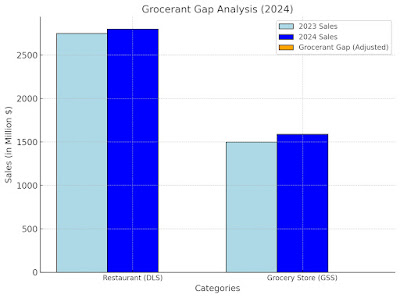Food
isn’t just fuel — it’s a mirror of culture, history, and innovation. Some of
the wildest food facts remind us that what’s on our plate has evolved over
centuries and across continents. But today, as consumers demand healthier,
fresher, more personalized options, the past offers clues about what’s next in
the rapidly growing “better-for-you” space according to Steven Johnson, Grocerant Guru®
at Tacoma, WA based Foodservice
Solutions®.
Let’s
start with a few timeless facts that might surprise you:
Fun Food Facts You Probably Didn’t Know
1. Bananas
are berries — strawberries are not.
Despite their name, strawberries don’t meet the botanical definition of a
berry. Bananas, however, do. Consumers are more curious than ever about what’s
real and what’s not in the world of food labels.
2. Honey
never spoils.
Found in Egyptian tombs over 3,000 years old, honey remains shelf-stable
forever. This natural preservation is one reason why “clean label” ingredients
are making a comeback in modern food production.
3. Peanuts
are not nuts.
Technically legumes, peanuts grow underground and are cousins to beans.
Ingredient education and sourcing transparency are increasingly driving grocery
and restaurant menu decisions.
4. Carrots
were originally purple.
Orange carrots didn’t exist until Dutch growers cultivated them in the 17th
century. Expect continued exploration of heirloom vegetables and plant-based
color to return.
5. Apples
float because they are 25% air.
That’s what makes them perfect for bobbing at fall festivals. Whole fruits are
still at the center of many “better-for-you” snacks, and innovations in
dehydrated and freeze-dried fruits will expand shelf life and usage occasions.
6. Cheese
is the most stolen food in the world.
About 4% of all cheese globally is stolen — food security and waste continue to
be topics grocery retailers and foodservice providers must tackle.
7. Broccoli
contains more protein than steak (per calorie).
Yes, ounce for ounce by calorie, broccoli beats steak in protein content.
Protein-rich vegetables will become meal centerpieces — not just sides — over
the next five years.
8. Ketchup
was once sold as medicine.
In the 1830s, it was marketed as a cure for indigestion. That health-halo
marketing hasn’t disappeared, but consumers today demand scientific backup and
transparency.
9. White
chocolate isn't technically chocolate.
It contains no cocoa solids, just cocoa butter, sugar, and milk solids. As
definitions and standards of identity evolve, expect consumers to push for
clearer labeling on everything from chocolate to “meatless” meats.
10. Potatoes
were the first vegetable grown in space.
NASA grew them aboard the Space Shuttle Columbia in 1995. Today, vertical
farming and space-aged growing techniques are transforming urban agriculture.
Five “Better-For-You” Trends to Watch in the Next Five
Years
With Insights from the Grocerant Guru®
As food evolves, so do consumer preferences. Here’s what’s coming next, according to Steven Johnson, the Grocerant Guru® at Foodservice Solutions®:
1. Mix-and-Match Meal Component Bundling
Consumers
no longer want full meals — they want components they can personalize.
Expect more retailers to offer protein bowls, veggie bases, and globally
flavored sauces that let customers mix health with familiarity.
“The
age of one-size-fits-all dinner is gone. Smart brands will let customers
co-create meals that are both satisfying and better-for-you,”
Johnson notes.
2. Functional Foods That Actually Work
Beyond
protein and fiber, consumers want foods that enhance focus, sleep, or
immunity. Think turmeric lattes, mushroom jerky, and collagen-infused
snacks.
“Function-forward food isn’t just a trend—it’s the new value proposition for health-conscious consumers,” Johnson explains.
3. Fresh Food at Non-Traditional Locations
C-stores,
gas stations, and pharmacies will lead in fresh ‘better-for-you’ offerings,
from low-sodium ready-to-eat meals to cold-pressed juices.
“The
line between grocer and restaurant is disappearing,” Johnson says. “Location is
no longer a barrier to fresh and healthy food.”
4. AI-Enhanced Personal Nutrition
Apps
and wearables will soon suggest real-time meals and snacks based on your
activity, sleep, or stress. Retailers and restaurants will use this data to personalize
recommendations and loyalty offers.
“Technology will turn personalized nutrition into everyday behavior. Expect AI to become your grocery co-pilot,” Johnson predicts.
5. Upcycled & Waste-Reducing Products
From
banana peel bacon to spent-grain protein bars, brands will double
down on sustainability through upcycling. Shoppers will reward zero-waste
innovation.
“Better-for-you
must now mean better-for-the-planet too,” Johnson emphasizes. “This dual value
will drive both product development and purchasing behavior.”
The Takeaway: From Ancient Foods to Futuristic Trends
History
tells us food constantly evolves. From 3,000-year-old honey to protein-rich
veggies grown in space, the innovation around what we eat and how we eat it is
only accelerating. For brands, restaurants, grocers, and convenience stores,
the challenge is clear: Stay ahead of changing consumer expectations—or
risk being left behind.
As
the Grocerant Guru® puts it, “Food today is interactive, participatory, and
customized. The ‘better-for-you’ future belongs to brands that understand that
the dinner table is wherever the customer is.”
Success Leaves Clues—Are You Ready to Find Yours?
One
key insight that continues to drive success is this: "The consumer is
dynamic, not static." This principle is the foundation of our work at Foodservice
Solutions®, where Steven Johnson, the Grocerant Guru®, has been
helping brands stay relevant in an ever-evolving market.
Want
to strengthen your brand’s connection with today’s consumers? Let’s talk.
Call 253-759-7869 for more information.
Stay Ahead of the Competition with Fresh Ideas
Is
your food marketing keeping up with tomorrow’s trends—or stuck in yesterday’s
playbook? If you're ready for fresh ideations that set your brand apart, we’re
here to help.
At
Foodservice Solutions®, we specialize in consumer-driven retail food
strategies that enhance convenience, differentiation, and
individualization—key factors in driving growth.
👉
Email us at Steve@FoodserviceSolutions.us
👉 Connect with us on social media:
Facebook,
LinkedIn,
Twitter








No comments:
Post a Comment